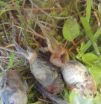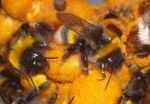(Press-News.org) KNOXVILLE—Amphibian declines and extinctions around the world have been linked to an emerging fungal disease called chytridiomycosis, but new research from the National Institute for Mathematical and Biological Synthesis (NIMBioS) shows that another pathogen, ranavirus, may also contribute.
In a series of mathematical models, researchers showed that ranavirus, which causes severe hemorrhage of internal organs in frogs, could cause extinction of isolated populations of wood frogs if they are exposed to the virus every few years, a scenario that has been documented in wild populations.
The most widely distributed amphibian species in North America, wood frogs have been shown to be highly susceptible to ranavirus infection, particularly as tadpoles. But little research has been done into how ranavirus affects frogs at all stages of their life cycle– from egg to hatchling to tadpole to metamorph, the stage when they emerge as frogs. Little is also known about how the infection could hasten extinction in entire populations.
The study, published in the journal EcoHealth, investigates the effect of ranavirus on the entire life cycle of wood frogs in demographically isolated populations, where there is no movement of frogs into the population from surrounding areas.
The study used mathematical simulations based on long-term data sets from wild populations of wood frogs in eastern United States and laboratory data on the effects of ranavirus. It determined that the life stage during which a frog was exposed to ranavirus was one of the most important factors in determining extinction and declines.
Extinction was most likely to occur when the tadpole or metamorph was exposed to ranavirus at frequent intervals in small populations. Under the worst-case scenario, extinction could occur in as quickly as five years with exposure every year and 25-44 years with exposure every two years.
The egg stage had a 57 percent survival rate when exposed to ranavirus, which was high enough to prevent extinction. Scientists speculate that eggs have a greater survival rate than other stages because they are protected by a thick gelatinous membrane that may serve as a structural barrier or contain anti-viral properties.
"Just as the chytrid fungus has decimated frog populations, the results of our study suggest that ranavirus infection too could contribute to extinction of amphibian populations that are demographically isolated," said lead author and NIMBioS postdoctoral fellow Julia Earl.
Amphibians are already considered the most imperiled of vertebrates, and a third of amphibians are threatened or endangered, according to the International Union for Conservation of Nature, the main international body that assesses the conservation status of species.
Disease may be playing a role in amphibians' extinction. Since the 1990s, chytridiomycosis, which has been called the worst disease affecting vertebrate animals in recorded history, has caused massive die-offs and species extinctions across the world, particularly in Australia, the Caribbean, and North, Central, and South America.
Ranavirus infections in amphibians have been known since the 1960s, but it wasn't until the 1980s when they were associated with large-scale mortality and disease.
Once exposed to ranavirus, in susceptible species like wood frogs, mortality can be as quick as three days. Transmission can occur through water, direct contact and when tadpoles scavenge other dead and infected frogs. There is no cure or treatment for the disease.
INFORMATION:
Citation: Earl JE, Gray MJ. June 2014. Introduction of ranavirus to isolated wood frog populations could cause local extinction. EcoHealth. DOI: 10.1007/s10393-014-0950-y
The National Institute for Mathematical and Biological Synthesis is an NSF-supported center that brings together researchers from around the world to collaborate across disciplinary boundaries to investigate solutions to basic and applied problems in the life sciences.
To learn more, visit http://www.nimbios.org.
CONTACT:
Catherine Crawley (865-974-9350, ccrawley@nimbios.org)
Julia Earl (865-974-4947, jearl@nimbios.org)
Study predicts ranavirus as potential new culprit in amphibian extinctions
2014-07-09
ELSE PRESS RELEASES FROM THIS DATE:
Study of dermatology on YouTube shows new ways science reaches public
2014-07-09
p>YouTube is for more than watching World Cup highlights, Brian Williams refreshing old school rap classics, and videos of skateboarders landing in unfortunate positions on railings. A University of Colorado Cancer Center study published in the Dermatology Online Journal shows that YouTube also allows researchers, journals, and health advocates to connect directly with the public on topics of skin cancer and prevention.
"No matter what field you're in, social media is the future of how we communicate around the world," says Chante Karimkhani, MD candidate in the lab of ...
Postcards from the photosynthetic edge
2014-07-09
A crucial piece of the puzzle behind nature's ability to split the water molecule during photosynthesis that could help advance the development of artificial photosynthesis for clean, green and renewable energy has been provided by an international collaboration of scientists led by researchers with the Lawrence Berkeley National Laboratory (Berkeley Lab) and the SLAC National Accelerator Laboratory.
Working at SLAC's Linac Coherent Light Source (LCLS), the world's most powerful x-ray laser, the researchers were able to take detailed "snapshots" of the four photon-step ...
Women's Medicine Collaborative examines safety of fecal transplant to treat C. difficile
2014-07-09
PROVIDENCE, R.I. – Researchers have found that fecal transplantation is effective and safe for treating C. difficile in immunocompromised patients. This is the result of a study led by Colleen Kelly, M.D., a gastroenterologist in the Center for Women's Gastrointestinal Medicine at The Women's Medicine Collaborative. The study and its findings have been published online in advance of print in the American Journal of Gastroenterology.
Clostridium difficile, or C. diff, has increased to epidemic proportions over the past decade. It is an infection that is often difficult ...
Controlling contamination in open algae ponds for biofuels
2014-07-09
New Rochelle, NY, July 9, 2014—Biofuels derived from the oils produced by algae may offer a low-cost sustainable alternative to fossil fuels. To achieve this goal, optimization of cost effective strategies for large-scale algae cultivation, such as in open pond systems, is needed. Sapphire Energy has developed an innovative solution to the challenge of contamination of open pond algae cultivation systems, described in Industrial Biotechnology, a peer-reviewed journal from Mary Ann Liebert, Inc., publishers. The article is available on the Industrial Biotechnology website. ...
New technology illuminates colder objects in deep space
2014-07-09
Too cool and faint, many objects in the universe are impossible to detect with visible light. Now a Northwestern University team has refined a new technology that could make these colder objects more visible, paving the way for enhanced exploration of deep space.
"High performance infrared cameras are crucial for space exploration missions," said Manijeh Razeghi, the Walter P. Murphy Professor of Electrical Engineering and Computer Science in Northwestern University's McCormick School of Engineering and Applied Science. "By studying the infrared waves emitted by cool ...
Immune function predicts infection risk among child trauma patients
2014-07-09
Researchers studying critically ill children with traumatic injuries have identified an immune marker that predicts which patients are likely to develop a hospital-acquired infection. The study, led by clinician-scientists at Nationwide Children's Hospital and published online in June in the journal Shock, is part of several larger efforts that could lead to the clinical implementation of quick-turnaround immune function tests and treatments to prevent or reverse immune system damage following critical illness or injury in pediatric patients.
Hospital-acquired, or nosocomial, ...
BU researchers relate arrests with HIV risk environment
2014-07-09
Boston—Practices used in policing injection drug users in Russia might contribute to HIV transmission and overdose mortality.
A study, conducted by researchers from Boston University Schools of Medicine and Public Health, in collaboration with St. Petersburg Pavlov State University, sought to discover the effect police arrests had on the health outcomes of a cohort of HIV-positive people with lifetime of injection drug use.
Those who were arrested by police were more likely to share needles—increasing HIV transmission—and to overdose, according to the study published ...
Miriam Hospital study examines effect of depressed mood on pulmonary rehab completion
2014-07-09
PROVIDENCE, R.I. -- Researchers from The Miriam Hospital have found that people with Chronic obstructive pulmonary disease (COPD) who are also depressed have difficulty sticking to a pulmonary rehabilitation program. This appears to be particularly true for women, and screening and brief treatment of depression should be considered as part of treatment. The study and its findings are published in print in Respiratory Medicine.
Chronic obstructive pulmonary disease is a common and often disabling inflammatory lung disease characterized by a progressive airway obstruction ...
Bee foraging chronically impaired by pesticide exposure: Study
2014-07-09
A study co-authored by a University of Guelph scientist that involved fitting bumblebees with tiny radio frequency tags shows long-term exposure to a neonicotinoid pesticide hampers bees' ability to forage for pollen.
The research by Nigel Raine, a professor in Guelph's School of Environmental Sciences, and Richard Gill of Imperial College London was published July 9 in the British Ecological Society's journal Functional Ecology.
The study shows how long-term pesticide exposure affects individual bees' day-to-day behaviour, including pollen collection and which flowers ...
Adults with special needs see gains, challenges with long term oral care
2014-07-09
BOSTON (July 9, 2014) — A retrospective study conducted by researchers at Tufts University School of Dental Medicine and colleagues reports that among adults with intellectual and developmental disabilities, the likelihood of having cavities decreased as the number of years receiving dental care increased. The findings, published in the July/August issue of Special Care in Dentistry, may help improve interventions designed to address the oral health of individuals in this population.
The researchers reviewed the dental records of 107 patients at one of the eight clinics ...





